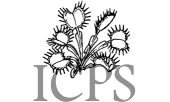|
Carnivorous Plant Newsletter
Volume 31, Number 3, September 2002, pages 78 - 82; Front Cover
Technical Refereed Contribution
Heliamphora chimantensis,
a New Species of Heliamphora (Sarraceniaceae)
from the ‘Macizo de Chimanta’ in the South of Venezuela
Andreas Wistuba • Mannheim • Germany
Thomas Carow • Münnerstadt • Germany
Peter Harbarth • Dossenheim • Germany
Keywords: new taxa: Heliamphora chimantensis, Venezuela.
Received: 8 February 2002
Introduction
During our January 2001 expedition to the tepuis of Venezuela (Wistuba et al., 2001), we also explored parts of the ‘Macizo de Chimanta’, the Chimanta Massif in the southwest part of the Gran Sabana. This huge massif covers a total area of 1470 km² and is actually a cluster of tepuis including the central Chimanta Tepui itself. Their peaks range in altitude from 1700 m (at the central part of the massif) to 2698 m (on Eruoda Tepui). The ten tepuis that reach 2000 m above sea level cover an area of some 700 km² in total (Huber, 1992). The size and the diverse altitudes of the Chimanta Massif support numerous habitats including rivers, green valleys and forests as well as rocky plateaus and moist savannas. Starting in the 1950s, various expeditions explored the unique flora and fauna of this area. Many endemic plants and animals were discovered during these expeditions and certainly many more await discovery.
During this exploration we found a previously undescribed species of Heliamphora most notable for its pitcher shape and the spoon shaped lids. This species seems to be more closely related to Heliamphora tatei than to any of the other species described so far from the Gran Sabana.
Heliamphora chimantensis Wistuba, Carow & Harbarth spec. nov.
Caudex ramosus; foliis caulescentibus vel rosulis; amphoriis in parte inferiore infundibuliformibus, in parte media subventricosis, et in parte superiore cylindricis ad leviter infundibuliformibus, longis 20-30 cm, latis (in parte superiore) 3.5 - 5 cm.
Inflorescentiis 3-5-floris, racemosis, ad 65 cm longis; flores nutantes; pedicellis 5-13 cm longis; petalis 4 lanceolatis, albidis vel pallide-roseis, 4-5.5 cm longis, 1.2-1.7 cm latis; staminibus ca. 20, 1-serialibus, filamentis 6 mm longis; antheris oblongo-lanceolatis, ca. 5 mm longis; ovario valde tomentoso; stylo glabro; stigmate 3 lobato; seminibus fuscis, oblongis, ca. 3 mm longis, testa conspicue membranaceo-alata.
Rhizomes branching. Plants forming dense and often huge patches up to several meters across.
Pitchers infundibulate in the lower half, slightly ventricose in the middle and cylindrical to slightly infundibulate in the upper third (see Figure 1); pitchers 20 to 35 cm long, 3.5-5 cm wide in the upper part; upper part of the pitchers completely glabrous on the inner side; pitchers entirely green with deep red lids. Lid 1-2 cm wide and 2-2.5 cm long, spoon-shaped, upright, ending with a sharp tip; the two lobes of the lid compressed from the sides near the tip, often touching each other at the front, forming a quasi-helmet; lobes are expanded in the lower part of the lid and narrowed sharply near the base; the inner side of the lid with prominent irregularly shaped patches of glands, up to 5 mm across. Inflorescence 60 to 65 cm long, 3-5 flowers, peduncle slightly pubescent, pedicels 5-13 cm long. The lowest peduncle is the longest and bears a bract that frequently is transformed into a rudimentary pitcher. Tepals lanceolate, 4.5-5.5 cm long, 1.2-1.7 cm wide, white to whitish-pink; ca. 20 stamens in 1 series, filaments 6 mm long, anthers oblong lanceolate, 5 mm long, 1 mm wide; ovary 3 celled, pubescent, style glabrous. Seed approximately 2 mm long, compressed, ovate, irregularly winged.
Specimens examined
Heliamphora chimantensis: Macizo de Chimanta, Section centro-oriental, 1921 m a.s.l., N 05°16.672’; W 062°11.438’ Wistuba, Carow & Harbarth No. Chim 10.01.01/1, holotype, flowering plant (VEN)
Heliamphora chimantensis: Macizo de Chimanta, Section centro-oriental, 1921 m a.s.l., N 05°16.672’; W 062°11.438’ Wistuba, Carow & Harbarth No. Chim 10.01.01/2, isotype, flowering plant (VEN)
The two herbarium specimens nicely exhibited the characteristics typical of the new species. The comments in this paper are based both upon these two specimens as well as our field observations of many other plants in situ.
Distribution
Heliamphora chimantensis sometimes grows together with H. minor, the only other species of Heliamphora recorded from Chimanta. As a consequence, hybrids frequently could be found. However, H. chimantensis seems to prefer valleys growing at around 2000 m while H. minor also has been found in higher altitudes and usually prefers more open habitats.
The H. minor plants on Chimanta are notable for the long and prominent bristles inside the pitchers. This variant form of H. minor is actually fairly widespread and has been found on many tepuis of the Chimanta Massif as well as on Aprada Tepui, but not Auyan Tepui. Meanwhile, the typical form of H. minor is only known from Auyan Tepui. The differences between these two forms of H. minor may merit further taxonomic study.
Ecology
Heliamphora chimantensis plants were found growing exposed, in short vegetation such as grasses, bromeliads, Xyris (Xyridaceae) or Stegolepis (Rapateaceae). These plants do not grow taller than the H. chimantensis. In fact, we never found plants growing in shaded locations. Often they grow near rivers in the valleys of Chimanta. In all cases we found Heliamphora chimantensis growing together with Stegolepis ligulata, and also often associated with Adenanthe bicarpellata (Ochnaceae) and various species of Brocchinia (Bromeliaceae).
In comparison to the species found on the plateaus of the various tepuis, where the surface usually is much more rocky and sandy and plants often can grow only on ‘islands’ of debris, highly limited in space, the moist savannah-like habitat H. chimantensis prefers allows the formation of huge clumps. We have visited many tepuis on this and other expeditions, and had never before seen clumped Heliamphora colonies of comparable in size to the ones typical of H. chimantensis. Vegetative reproduction seems to play an important role as the seedling activity we observed was very low.
The lids of H. chimantensis bear strange, huge patches (up to 5 mm across) of glands on their inner surface (Figure 3). They should be studied in more detail as they seem to be involved in the attraction of prey. We observed ants and wasps being attracted by secretions of these glands but unfortunately our limited time on Chimanta did not permit a detailed study. As we have observed with other species of Heliamphora, the pitchers usually do not contain many captured insects.
Related species
The discovery of H. chimantensis on Chimanta and its characteristics came as quite a surprise, as they clearly indicate that it is much more closely related to the southern H. tatei, than to any of the northern species known to be growing in the Gran Sabana. The flowers of all other species known from the Gran Sabana have 10-15 anthers, while Heliamphora tatei var. tatei and H. tatei var. neblinae from the Amazon, and Heliamphora chimantensis have about 20; however, while the anthers of H. tatei and H. tatei var. neblinae are 7-9 mm long, those of H. chimantensis just reach 5 mm in length (Maguire, 1978; Steyermark, 1984).
The nectar spoons of the other species from the Gran Sabana are shaped more or less concave to form helmet-like structures under which nectar can accumulate, protected from the frequent rainfalls. In H. tatei, as well as in H. chimantensis, the lids are more upright. However, H. chimantensis protects its nectar production by the two lobes of the lid which are bent forwards and are compressed from the sides to form a roof reminiscent of the helmets of the other north-eastern species. From the ones of H. tatei the lids of H. chimantensis differ by the spoon-shape and the sharp contraction at the base. In H. tatei the lids are only very slightly contracted at the base and rather rectangular in shape.
Hybrids
We observed numerous hybrids between Heliamphora chimantensis and the Heliamphora minor on Chimanta. These hybrids can be easily distinguished from pure Heliamphora chimantensis by the shorter pitchers, the red veins and the coarse bristles inside the pitchers. Some of the hybrids’ pitchers showed deep red coloration, similar to the form of H. minor growing on Chimanta. The helmet shaped lids of these show a strong influence of Heliamphora minor. Apparently the hybrids are much more vigorous than either of the parent plants; we found patches of single clones measuring more than 5 meters across (see Front Cover).
Etymology
This name was chosen as Heliamphora chimantensis because it is the only species known to be restricted to Chimanta Tepui.
Discussion
The formation of huge clumps and the low seedling activity seem to be the consequence of the savanna-like habitat. In general, the seeds of Heliamphora clearly show adaptations to dispersal by water. This works excellently on a “typical” tepui where little streams and shallow ponds carry the seeds to new small patches of debris, making Heliamphora a kind of pioneer plant. However, the environment in the valleys on Chimanta where we found Heliamphora chimantensis seems to be far more static, with a well developed, continuous soil layer. The low vegetation might be too dense for seedlings to germinate and grow. Those few seedlings which do survive to maturity can develop into patches of huge size.
Although the large sizes of the clumps that Heliamphora chimantensis makes are remarkable, they are not completely unprecedented. Heliamphora can multiply vegetatively by division, but in most species the resulting clumps still remain small due to limitations of the detritus patches they grow in. Even so, we have observed similar, large-clump growth patterns in Heliamphora hispida (Nerz & Wistuba, 2000), Heliamphora heterodoxa (in the Gran Sabana) and Heliamphora nutans growing on the sandy foothill area of Tramen Tepui.
As we already discussed in our publication on Heliamphora folliculata (Wistuba et al., 2001) the pitcher-lids or so called nectar-spoons of Heliamphora are highly elaborate structures for the attraction of prey. Apparently various strategies have been developed by the different species of Heliamphora all using the lids in altered ways. Heliamphora chimantensis with its gland-patches shows yet another way to use the lid-structure for the attraction of insects.
Being morphologically fairly constant organs, the lids offer superb, yet previously under-utilized, characters of taxonomic relevance (cf. Nerz &Wistuba, 2000; Wistuba et al., 2001).
Literature
Huber, O. 1992, El macizo del Chimantá, Oscar Todtmann Editores.
Maguire, B. 1978, Sarraceniaceae (Heliamphora), in: The Botany of the Guyana Highland Part-X, Memoirs of the New York Botanical Garden, 29: 36-61.
Nerz, J. and Wistuba, A. 2000, Heliamphora hispida (Sarraceniaceae), a New Species from Cerro Neblina, Brazil-Venezuela. Carniv. Pl. Newslett. 29: 37-41.
Steyermark, J.A. 1984, Venezuelan Guyana, Annals of the Missouri Botanical Garden, 71: 302-312.
Wistuba, A., Harbarth, P. and Carow, T. 2001, Heliamphora folliculata, a New Species of Heliamphora (Sarraceniaceae) from the ‘Los Testigos’ Table Mountains in the South of Venezuela. Carniv. Pl. Newslett. 30:120-125.
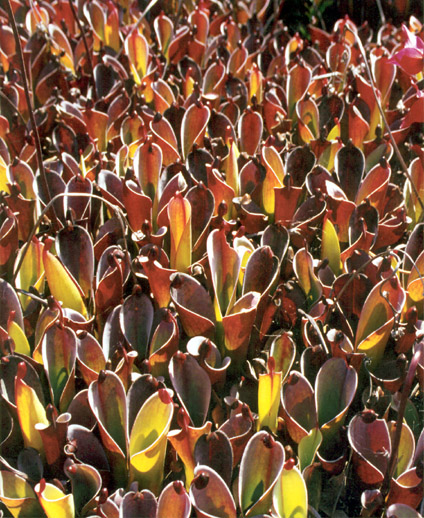
Front Cover: Heliamphora chimantensis x Heliamphora minor plants. Photograph by Andreas Wistuba.
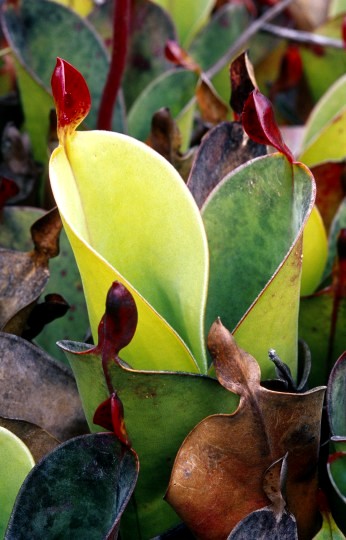
Figure 1: Heliamphora chimantensis pitcher. Photograph by Andreas Wistuba.
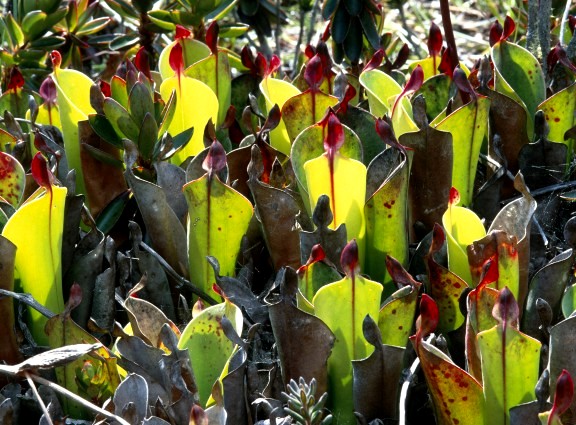
Figure 2: Cluster of Heliamphora chimantensis pitchers. Photograph by Andreas Wistuba.
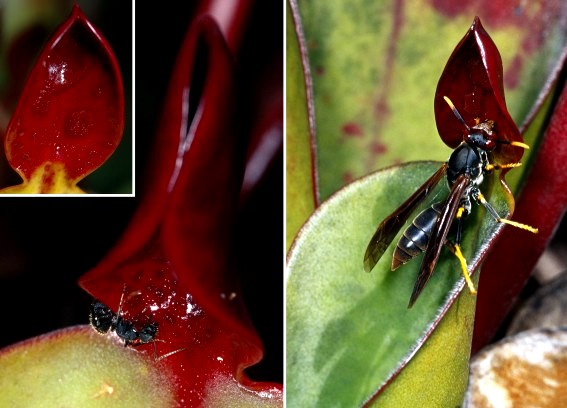
Figure 3: Heliamphora chimantensis pitcher appendage nectar patches (left inset) and insect visitation; ant (left), wasp (right). Photographs by Thomas Carow.
|
